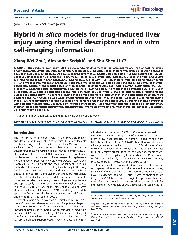摘要
Drug-induced liver injury (DILI) is a major adverse drug reaction that accounts for one-third of post-marketing drug withdrawals. Several classifiers for human hepatotoxicity using chemical descriptors with limited prediction accuracies have been published. In this study, we developed predictive in silico models based on a set of 156 DILI positive and 136 DILI negative compounds for DILI prediction. First, models based on a chemical descriptor (CDK, Dragon and MOE) and in vitro cell-imaging endpoints [human hepatocyte imaging assay technology (HIAT) descriptors] were built using random forest (RF) and five-fold cross-validation procedure. Then three hybrid models were built using HIAT and a single type of chemical descriptors. Generally, the models based only on chemical descriptors were poor, with a correct classification rate (CCR) around 0.60 when the default threshold value (i.e. threshold=0.50) was used. The hybrid models afforded a CCR of 0.73 with a specificity of 0.74 and a better true positive rate (sensitivity of 0.71), which is crucial in drug toxicity screening for the purpose of patient safety. The benefit of hybrid models was even more drastic when stricter classification thresholds were employed (e.g. CCR would be 0.83 when double thresholds (non-toxic<0.40 and toxic > 0.60) were used for the hybrid model). We have developed rigorously validated hybrid models which can be used in virtual screening of lead compounds with potential hepatotoxicity. Our study also showed a chemical structure and in vitro biological data can be complementary in enhancing the prediction accuracy of human hepatotoxicity and can afford rational mechanistic interpretation.
- 出版日期2014-3
- 单位同济大学
